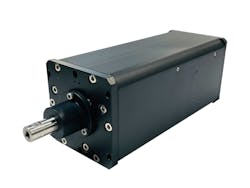SMAC LPL80 Electric Actuators Provide Programmable Speed and Positioning
SMAC Moving Coil Actuators (SMAC) has added the LPL80 electric linear moving coil actuators to its offering. The actuators are designed to offer a replacement to pneumatics in liquid filling machines.
Features of the LPL80 actuators include:
- fully programmable
- peak force of 170 Newton
- soft-land capability
- standard dimensions for filling machines.
More Precision and Control Than Pneumatics
SMAC designed the LPL80 electric actuators specifically to meet the requirements of filling machines. According to SMAC, filling applications have very specific force requirements which the company's electric actuators are better able to meet than the pneumatic actuators (aka air cylinders) typically utilized.
The actuators have a peak force of 170 Newton and are fully programmable to ensure precise force control. SMAC founder and CEO Ed Neff said the ability to precisely control speed and position are important in this application and not possible with pneumatic alternatives.
Pneumatic actuators used in this application tend to have only two positions and one set speed available, though there are versions with three positions and two speeds. However, the LPL80 electric actuators enable programmable speed and positioning down to the micron level states SMAC in its press release announcing the launch of the actuators.
"This is quite useful in many filling situations, such as when an initial slow fill is needed to prevent foaming, which can be combined with a fast middle speed for quick filling and then a programmed to slow down in cases where the container top necks down," explained Neff.
READ MORE: Electric Actuators Becoming Viable Alternative to Pneumatics
The actuators also offer the benefit of faster cycle times which can benefit productivity for manufacturers. With peak cycle rates of 2,400 cycles per minute, the electric actuators are three times faster than air cylinders. Their programmability helps to minimize harsh stops and starts, leading to less premature wear.
Inclusion of SMAC's soft-land capability enables the actuators to gently approach a surface, further helping to reduce wear while also enable use for more delicate applications. The soft-land technology also provides real-time feedback for tracking, performance and quality control.
Additional features of the LPL80 electric actuators include a standard stroke of 25 mm, with other options available, and an IP67 rating to ensure resistance to water. Versions with IP69 ratings are also available.
About the Author
Sara Jensen
Executive Editor, Power & Motion
Sara Jensen is executive editor of Power & Motion, directing expanded coverage into the modern fluid power space, as well as mechatronic and smart technologies. She has over 15 years of publishing experience. Prior to Power & Motion she spent 11 years with a trade publication for engineers of heavy-duty equipment, the last 3 of which were as the editor and brand lead. Over the course of her time in the B2B industry, Sara has gained an extensive knowledge of various heavy-duty equipment industries — including construction, agriculture, mining and on-road trucks —along with the systems and market trends which impact them such as fluid power and electronic motion control technologies.
You can follow Sara and Power & Motion via the following social media handles:
X (formerly Twitter): @TechnlgyEditor and @PowerMotionTech
LinkedIn: @SaraJensen and @Power&Motion
Facebook: @PowerMotionTech

Leaders relevant to this article:

